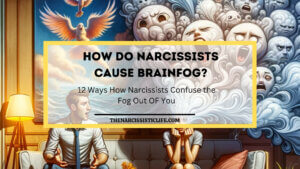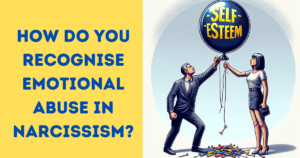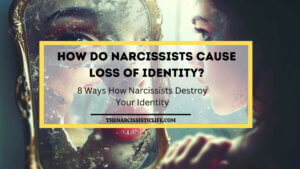
In relationships with narcissists, those involved often end up wondering about their sense of reality.
Relationships with Narcissists often start with excitement and many promises (known as the love bombing phase) but often lead to a tough cycle of emotional ups and downs.
It’s not easy to recognize the signs of narcissistic abuse because the charm that first captivated you can hide the bad behavior. But eventually, it becomes clear that you were not an equal partner but a piece in their game of self-importance and power.
This article aims to make sense of the confusing situations created by narcissists. It’s here to explain the hidden ways of narcissistic abuse and to be a light for those finding their way back to feeling okay.
Trapped In The Web Of The Narcissist
Narcissistic relationships usually start exciting and enthusiastic, only to suddenly crash into a pit of feeling less worthy.
Idealization
It all begins with the “idealization phase,” where the narcissist showers you with love, making you feel very special. But all those compliments and kind actions are tricks to win your trust and love.
Yet, this special place where you’ve been put is not as secure as it seems. It’s more like you’re standing on a trap door that could swing open the minute you stop being useful to the narcissist.
Devaluation
That’s when the “devaluation phase” starts. Suddenly, the kindness turns into coldness, and the things about you that were once praised are now used against you.
You eventually figure out that the narcissist’s great affection was all fake, just a way to control how you feel and make sure you stay loyal.
Discard
The last part of this painful cycle is the “discard.” It’s a harsh and sudden end to the relationship that can leave you confused and hurt. The narcissist does this to get out of a relationship that’s no longer useful to them without showing any care or real emotion.
When you’re caught in this cycle of fake love and your feelings being torn down, it’s tough to see what the narcissist is really up to. They switch between liking and looking down on you, which keeps you constantly worried. It’s hard to accept that their love was never real.
After the Breakup
After the relationship is over, healing starts with understanding these tricky tactics. It’s not easy because you might feel betrayed and doubt yourself.
But it’s necessary for getting over the narcissist’s influence and finding who you are again. As you see things more clearly, you become stronger from what you’ve been through, ready to find true happiness without the narcissist’s lies.
Identifying Narcissistic Behavior
Spotting the actions of a narcissist can be like noticing the small shakes that come before a big earthquake; they might be hard to catch at first, but once you see the pattern, it’s clear.
Narcissists are often super charming and self-assured, drawing you in and even making you admire them.
Lack of Empathy
But underneath, they need others to look up to them and feel good about themselves based on how others see them.
One big clue to narcissistic behavior is that they don’t have much empathy—they find it hard to understand or care about what other people feel or need.
They tend to see relationships in a give-and-take way, where they value others for what they can get from them, like attention or benefits.
Once they stop getting what they want, they often lose interest and may leave the other person feeling hurt.
They Lie
Narcissists also commonly lie a lot. They twist the truth to fit the story they want to tell.
They might leave out details, make you doubt your memories, or straight-up lie to keep control and look flawless.
They don’t want to admit they’re wrong because that would mean showing weakness, which goes against their image of always being right.
They Manipulate You
Manipulation is a big part of dealing with a narcissist. This can be either not-so-obvious ways, like making you feel guilty or pretending they can’t do things for themselves, or more direct ways, like threatening or insulting you to get their way.
The main goal is to turn things in their favor. People on the receiving end may feel like the narcissist is always trying to push their limits and take over their time, thoughts, and feelings.
Recognizing these actions is important because they show the line between respecting each other and mental invasion.
Knowing what narcissistic abuse looks like helps you see the confusion that comes from a narcissist saying they care but then causing harm.
With this knowledge, someone can better defend themselves against the narcissist’s impact and start getting better.
Recovery means understanding the signs, trusting what you feel is right, and having the courage to walk away from the chaos a narcissist brings.
The Consequences of a Narcissistic Relationship
Getting out of a relationship with a narcissist often leaves a lasting effect on someone’s mind. It can shake your trust and self-esteem, making it tough to return to feeling normal.
At first, the intense adoration from a narcissist can seem special and make you feel really good. But when the stage where they treat you like you’re perfect ends, you’re hit with sharp criticism and eventually pushed away completely.
For the person on the receiving end, this harsh switch from being loved to hated can cause a lot of mental problems.
Anxiety and Depression
It’s common to feel anxious or depressed because the narcissist’s feelings for you can change without warning, making you feel like you need to earn their approval all the time.
The drop in self-confidence is huge; qualities that used to be praised are suddenly seen as faults through the narcissist’s judgment.
After being with a narcissist, it’s hard to trust yourself or anyone else. You might keep questioning your choices, especially when trying to please the narcissist didn’t work.
Getting close to someone can feel like too much risk when emotionally drained. Relationships, which should make you happy and feel connected, become scary because you’re worried about being lied to or hurt again.
How To Make Sense Of It All?
You might ask yourself tough questions: How did I miss all the signs? Why did I put up with so much for so long?
These are the thoughts of someone trying to make sense of the betrayal and fix their broken heart.
Outside, your friendship and work might also take a hit as the effects of the narcissist’s bad behavior make it hard to trust and be open with others.
To heal, it’s important to realize the harm that was done and to know you didn’t deserve any of the bad treatment.
The road to feeling better includes admitting the pain you’ve been through, believing you’re a good and capable person, and putting together the scattered parts of who you are.
People who have been through this need to work on becoming strong again and getting back to a life free from the controlling influence of the narcissist.
Strategies for Recovery and Healing
Moving on from a relationship with a narcissist is a big step towards getting better, but the journey to recovery is personal and can often be complicated.
Once people manage to get out of the narcissist’s influence, it’s important to think about ways to heal and grow. The goal is to value yourself again and build a life centered around understanding and kindness towards oneself.
No Contact
One key part of healing is deciding to have No Contact with the narcissist. Cutting off all communication isn’t being mean—it’s a crucial way to protect yourself from further mental hurt.
It’s about setting a clear boundary and telling yourself that the emotional battles are over. When you stop the narcissist from being able to reach out to you, you also take away their power to play with your feelings.
Boundaries
The next step to protect yourself is to set firm boundaries. By being clear about what kind of behavior you will accept from others and sticking to these rules, you help prevent being taken advantage of again.
Boundaries show self-respect; they confirm your right to feel emotionally safe and to have your own space. You might need to change the way you interact with friends, at work, or online to create a safe space where you can heal.
Educate Yourself
To avoid feeling unwarranted guilt or blaming yourself, it’s vital to understand how narcissistic abuse works.
Learning about it can clear up a lot of confusion, making it clear that the way the narcissist acted was because of their issues, not because of who you are or what you did.
Groups where people support each other and therapy can be very helpful, as they give you a place to talk about what you went through and feel understood.
Take Care of Yourself
Taking care of yourself becomes very important after dealing with narcissistic abuse. It’s a chance to put your well-being first and do things that bring you comfort and happiness.
This could be through quiet reflection, being active, being creative, or resting. Taking care of yourself shows you recognize your worth, and it’s a way to honor how strong and resilient you are.
Following these approaches helps build a brighter future where past difficulties don’t control how you live.
Recovery is more than just making it through; it’s about doing well, taking charge of your story, and looking forward to real joy and truth after going through tough times.
To Conclude
Walking away from the complicated maze that a relationship with a narcissist can create is a true sign of inner strength.
Those who make it through come out stronger and wiser, showing how much people can recover and find hope again.
The road to feeling better has its ups and downs, but also allows you to find new confidence and take control of your life. It’s a powerful reminder that even though your history might include manipulation and pain, your future is an open space where you can live freely and joyfully.
By taking back your story from someone who used narcissistic abuse, you show that those experiences, as painful as they were, don’t limit who you are.
Looking ahead, the scars act as rewards for your courage, symbols of what you’ve overcome, and the foundations for a brighter, more confident future.
Recommendation for Further Reading
For those seeking more comprehensive understanding and strategies in dealing with narcissistic abuse, below is a list of further reading that can offer valuable insight and support:
- “Psychopath Free: Recovering from Emotionally Abusive Relationships with Narcissists, Sociopaths, and Other Toxic People” by Jackson MacKenzie – This book guides survivors through the stages of recovery from toxic relationships, providing practical advice and validation.
- “Will I Ever Be Good Enough? Healing the Daughters of Narcissistic Mothers” by Dr. Karyl McBride – While focused on daughters of narcissistic mothers, this book offers valuable perspectives on the broader implications of narcissistic abuse and strategies for healing.
- “Disarming the Narcissist: Surviving and Thriving with the Self-Absorbed” by Wendy T. Behary – This resource provides tools to effectively navigate relationships with narcissists, with techniques grounded in cognitive behavioral and schema therapy.
- “The Object of My Affection Is in My Reflection: Coping with Narcissists” by Rokelle Lerner – Offering insights into the narcissist’s mindset and behaviors, this book helps readers understand and cope with narcissists in their lives.
- “Becoming the Narcissist’s Nightmare: How to Devalue and Discard the Narcissist While Supplying Yourself” by Shahida Arabi – The book empowers victims by detailing how to take control of their lives, heal from abuse, and ultimately become stronger.
- “The Wizard of Oz and Other Narcissists: Coping with the One-Way Relationship in Work, Love, and Family” by Eleanor D. Payson – Using a familiar narrative, this book explores the dynamics of narcissistic relationships and provides practical advice for coping and thriving.



